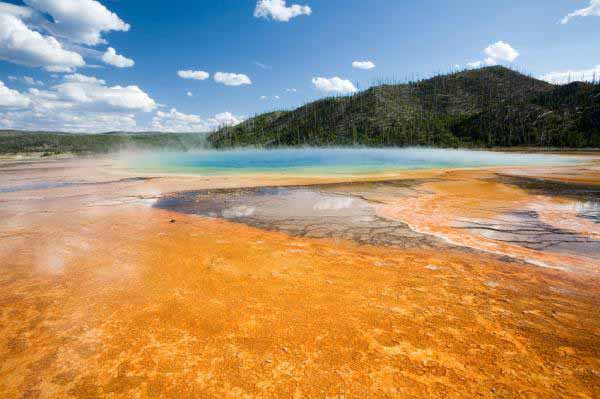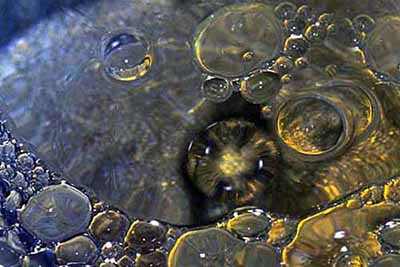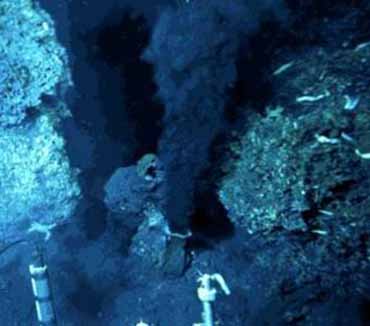

The Primordial Soup Theory suggest that 3.8 billion to 3.55 billion years ago life began in a pond or ocean as a result of the combination of chemicals from the atmosphere and some form of energy to make amino acids, the building blocks of proteins, which would then evolve into the first species on Earth.
Primordial soup is a term introduced by the Soviet biologist Alexander Oparin. In 1924, he proposed the theory of the origin of life on Earth through the transformation, during the gradual chemical evolution of molecules that contain carbon in the primordial soup. Biochemist Robert Shapiro has summarized the "primordial soup" theory of Oparin and Haldane in its "mature form" as follows:
2. This atmosphere, exposed to energy in various forms, produced simple organic compounds ("monomers").
3. These compounds accumulated in a "soup", which may have been concentrated at various locations (shorelines, oceanic vents etc.).
4. By further transformation, more complex organic polymers - and ultimately life - developed in the soup.
One of the most important pieces of experimental support for the "soup" theory came in 1953. A graduate student, Stanley Miller, and his professor, Harold Urey, performed an experiment that demonstrated how organic molecules could have spontaneously formed from inorganic precursors, under conditions like those posited by the Oparin-Haldane Hypothesis. The now-famous "Miller-Urey experiment" used a highly reduced mixture of gases - methane, ammonia and hydrogen - to form basic organic monomers, such as amino acids. This provided direct experimental support for the second point of the "soup" theory, and it is around the remaining two points of the theory that much of the debate now centers.
Apart from the Miller-Urey experiment, the next most important step in research on prebiotic organic synthesis was the demonstration by Joan Oro that the nucleic acid purine base, adenine, was formed by heating aqueous ammonium cyanide solutions.
In support of abiogenesis in eutectic ice, more recent work demonstrated the formation of s-triazines (alternative nucleobases), pyrimidines (including cytosine and uracil), and adenine from urea solutions subjected to freeze-thaw cycles under a reductive atmosphere (with spark discharges as an energy source).
The spontaneous formation of complex polymers from abiotically generated monomers under the conditions posited by the "soup" theory is not at all a straightforward process. Besides the necessary basic organic monomers, compounds that would have prohibited the formation of polymers were formed in high concentration during the Miller-Urey and Oro experiments. The Miller experiment, for example, produces many substances that would undergo cross-reactions with the amino acids or terminate the peptide chain.
More fundamentally, it can be argued that the most crucial challenge unanswered by this theory is how the relatively simple organic building blocks polymerize and form more complex structures, interacting in consistent ways to form a protocell. For example, in an aqueous environment hydrolysis of oligomers/polymers into their constituent monomers would be favored over the condensation of individual monomers into polymers.

Abiogenesis or biopoiesis is the natural process by which life arises from inorganic matter. The earliest known life on Earth existed between 3.9 and 3.5 billion years ago, during the Eoarchean Era when sufficient crust had solidified following the molten Hadean Eon.
Scientific hypotheses about the origins of life may be divided into several categories. Most approaches investigate how self-replicating molecules or their components came into existence. For example, the Miller-Urey experiment and similar experiments demonstrated that most amino acids, often called "the building blocks of life", can be racemically synthesized in conditions thought to be similar to those of the early Earth. Several mechanisms have been investigated, including lightning and radiation. Other approaches ("metabolism first" hypotheses) focus on understanding how catalysis in chemical systems in the early Earth might have provided the precursor molecules necessary for self-replication.
Power behind primordial soup discovered PhysOrg - April 4, 2013

Researchers at the University of Leeds may have solved a key puzzle about how objects from space could have kindled life on Earth. While it is generally accepted that some important ingredients for life came from meteorites bombarding the early Earth, scientists have not been able to explain how that inanimate rock transformed into the building blocks of life.
This new study shows how a chemical, similar to one now found in all living cells and vital for generating the energy that makes something alive, could have been created when meteorites containing phosphorus minerals landed in hot, acidic pools of liquids around volcanoes, which were likely to have been common across the early Earth.
"The mystery of how living organisms sprung out of lifeless rock has long puzzled scientists, but we think that the unusual phosphorus chemicals we found could be a precursor to the batteries that now power all life on Earth. But the fact that it developed simply, in conditions similar to the early Earth, suggests this could be the missing link between geology and biology," said Dr Terry Kee, from the University's School of Chemistry, who led the research.
All life on Earth is powered by a process called chemiosmosis, where the chemical adenosine triphosphate (ATP), the rechargeable chemical 'battery' for life, is both broken down and re-formed during respiration to release energy used to drive the reactions of life, or metabolism. The complex enzymes required for both the creation and break down of ATP are unlikely to have existed on the Earth during the period when life first developed. This led scientists to look for a more basic chemical with similar properties to ATP, but that does not require enzymes to transfer energy.
Phosphorus is the key element in ATP, and other fundamental building blocks of life like DNA, but the form it commonly takes on Earth, phosphorus (V), is largely insoluble in water and has a low chemical reactivity. The early Earth, however, was regularly bombarded by meteorites and interstellar dust rich in exotic minerals, including the far more reactive form of phosphorus, the iron-nickel-phosphorus mineral schreibersite.
The scientists simulated the impact of such a meteorite with the hot, volcanically-active, early Earth by placing samples of the Sikhote-Alin meteorite, an iron meteorite which fell in Siberia in 1947, in acid taken from the Hveradalur geothermal area in Iceland. The rock was left to react with the acidic fluid in test tubes incubated by the surrounding hot spring for four days, followed by a further 30 days at room temperature.
In their analysis of the resulting solution the scientists found the compound pyrophosphite, a molecular 'cousin' of pyrophosphate - the part of ATP responsible for energy transfer. The scientists believe this compound could have acted as an earlier form of ATP in what they have dubbed 'chemical life'.
"Chemical life would have been the intermediary step between inorganic rock and the very first living biological cell. You could think of chemical life as a machine Ša robot, for example, is capable of moving and reacting to surroundings, but it is not alive. With the aid of these primitive batteries, chemicals became organized in such a way as to be capable of more complex behavior and would have eventually developed into the living biological structures we see today," said Dr Terry Kee.
The team from NASA's Jet Propulsion Laboratory (JPL-Caltech) working on the Curiosity rover, which landed on Mars in August last year, has recently reported the presence of phosphorus on the Red Planet. "If Curiosity has found phosphorus in one of the forms we produced in Iceland, this may indicate that conditions on Mars were at one point suitable for the development of life in much the same way we now believe it developed on Earth," added Dr Kee.
The team at Leeds are now working with colleagues at JPL-Caltech to understand how these early batteries and the 'chemical life' they became part of might have developed into biological life. As part of this work they will be using facilities in the University of Leeds' Faculty of Engineering, currently used to test new fuel cells, to build a 'geological fuel cell' using minerals and gases common on the early Earth. Researchers will apply different chemicals to its surface and monitor the reactions take place and the chemical products which develop.
The team also hope to travel to Disko Island in Greenland which is home to the Earth's only naturally-occurring source of schreibersite, the mineral found in the Sikhote-Alin meteorite. Here, they hope to repeat their experiments and show that the same chemicals develop in an entirely Earth-originated setting.
New Research Rejects 80-Year Theory of 'Primordial Soup' as the Origin of Life Science Daily - February 3, 2010

For 80 years it has been accepted that early life began in a 'primordial soup' of organic molecules before evolving out of the oceans millions of years later. Today the 'soup' theory has been over turned in a pioneering paper in BioEssays which claims it was the Earth's chemical energy, from hydrothermal vents on the ocean floor, which kick-started early life.
"Textbooks have it that life arose from organic soup and that the first cells grew by fermenting these organics to generate energy in the form of ATP. We provide a new perspective on why that old and familiar view won't work at all," said team leader Dr Nick lane from University College London. "We present the alternative that life arose from gases (H2, CO2, N2, and H2S) and that the energy for first life came from harnessing geochemical gradients created by mother Earth at a special kind of deep-sea hydrothermal vent -- one that is riddled with tiny interconnected compartments or pores."
The soup theory was proposed in 1929 when J.B.S Haldane published his influential essay on the origin of life in which he argued that UV radiation provided the energy to convert methane, ammonia and water into the first organic compounds in the oceans of the early earth. However critics of the soup theory point out that there is no sustained driving force to make anything react; and without an energy source, life as we know it can't exist.
"Despite bioenergetic and thermodynamic failings the 80-year-old concept of primordial soup remains central to mainstream thinking on the origin of life," said senior author, William Martin, an evolutionary biologist from the Insitute of Botany III in Dusseldorf. "But soup has no capacity for producing the energy vital for life."
In rejecting the soup theory the team turned to the Earth's chemistry to identify the energy source which could power the first primitive predecessors of living organisms: geochemical gradients across a honeycomb of microscopic natural caverns at hydrothermal vents. These catalytic cells generated lipids, proteins and nucleotides which may have given rise to the first true cells.
The team focused on ideas pioneered by geochemist Michael J. Russell, on alkaline deep sea vents, which produce chemical gradients very similar to those used by almost all living organisms today -- a gradient of protons over a membrane. Early organisms likely exploited these gradients through a process called chemiosmosis, in which the proton gradient is used to drive synthesis of the universal energy currency, ATP, or simpler equivalents. Later on cells evolved to generate their own proton gradient by way of electron transfer from a donor to an acceptor. The team argue that the first donor was hydrogen and the first acceptor was CO2.
"Modern living cells have inherited the same size of proton gradient, and, crucially, the same orientation -- positive outside and negative inside -- as the inorganic vesicles from which they arose" said co-author John Allen, a biochemist at Queen Mary, University of London.
"Thermodynamic constraints mean that chemiosmosis is strictly necessary for carbon and energy metabolism in all organisms that grow from simple chemical ingredients [autotrophy] today, and presumably the first free-living cells," said Lane. "Here we consider how the earliest cells might have harnessed a geochemically created force and then learned to make their own." This was a vital transition, as chemiosmosis is the only mechanism by which organisms could escape from the vents. "The reason that all organisms are chemiosmotic today is simply that they inherited it from the very time and place that the first cells evolved -- and they could not have evolved without it," said Martin.
"Far from being too complex to have powered early life, it is nearly impossible to see how life could have begun without chemiosmosis," concluded Lane. "It is time to cast off the shackles of fermentation in some primordial soup as 'life without oxygen' -- an idea that dates back to a time before anybody in biology had any understanding of how ATP is made."